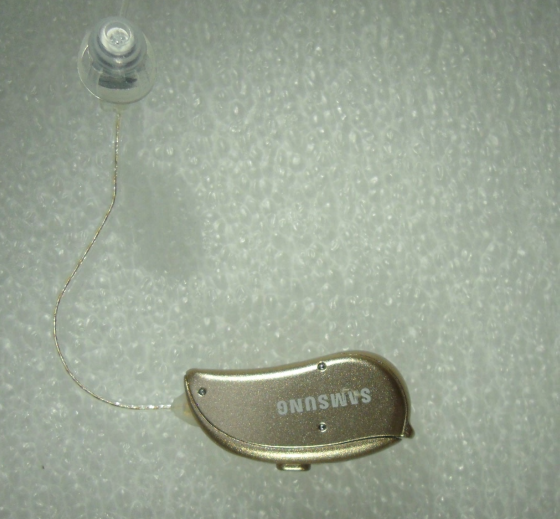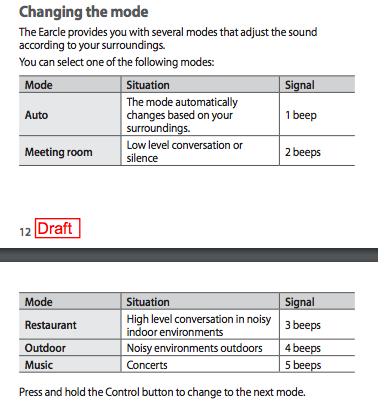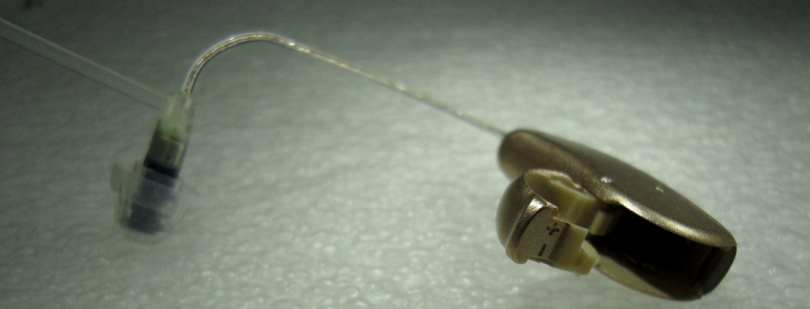aNewDomain — As the hype around so-called hearable technology continues to build, Samsung appears to be readying Bluetooth-enabled hearing aids and consumer-targeted hearables for U.S. release this year and next, according to sources close to the company and documents available in the public domain.

The so-called Samsung Earcle will be a non-prescription hearing device designed to work with Samsung Galaxy smartphones, FCC docs prepared by Samsung last year suggest.
The wireless Bluetooth device will be capable of enhancing conversation and other sounds in various settings, such as in loud concert halls, noisy restaurants and muted conference rooms, the docs say. The Earcle would also provide some access to such smartphone functions as messaging and playing music, and it would function as a standalone wireless Bluetooth headset, too, they say.
It’s possible, of course, that Samsung has abandoned or altered these plans in favor of the prescription-only Samsung Bluetooth Hearing Aid that is detailed in its Dec. 2015 Bluetooth SIG applications. We are awaiting Samsung comment.
But a close examination of the FCC docs around the Earcle non-prescription hearable portrays a product that fits in pretty neatly among the some dozen hearable entries just announced at CES 2016.
Scroll below the fold to view all the FCC and Bluetooth docs we found that describe the Samsung Earcle and the Samsung Bluetooth Hearing Aid.
This year so far has been a busy one in the nascent hearables sector, where more than a dozen companies have announced hearables — in-ear devices capable of delivering some smartphone functions (like messaging, music playing and fitness  monitoring) along with noise-cancellation and sound-enhancement functions via Bluetooth and built-in storage. The Bragi Dash, for instance, purports to offer music playback, messaging, fitness tracking, voice commands and other functions via two, independent ear pieces with no attachments. That firm recently announced that it’s working with hearing-aid maker Starkey. Apple, too, is believed to be working on both a hearing aid and a wireless “airpods” version of its EarPods, sources say, pointing to this trademark application, filed in September 2015.
monitoring) along with noise-cancellation and sound-enhancement functions via Bluetooth and built-in storage. The Bragi Dash, for instance, purports to offer music playback, messaging, fitness tracking, voice commands and other functions via two, independent ear pieces with no attachments. That firm recently announced that it’s working with hearing-aid maker Starkey. Apple, too, is believed to be working on both a hearing aid and a wireless “airpods” version of its EarPods, sources say, pointing to this trademark application, filed in September 2015.
The Samsung Earcle offering described in the FCC docs we’ve obtained doesn’t appear to be quite as ambitious, design-wise, as most of those efforts. Rather, its two independent earpieces connect to receivers that fit behind the ear.
This effort appears to be utterly distinct from Samsung efforts to build a Bluetooth hearing aid, as revealed by other public domain documents.
In the Earcle draft manual it sent to the FCC in October, Samsung repeately underlines that the Earcle is not designed for hearing-impaired individuals.
Rather, it is “intended to supplement what you hear by amplifying ambient sound … and does not compensate for hearing loss or hearing difficulty.
The docs also contain a tidy description of what Samsung has in mind for the Earcle. In the FCC application, Samsung writes:
The Earcle is … a personal sound amplification product (PSAP) to help you hear better. The Earcle amplifies the sound you hear and can also be used as a Bluetooth headphone. If you connect the Earcle to a mobile device via Bluetooth, you can answer calls and play music from the connected device. If you connect the Earcle to a mobile device via the Samsung Earcle app installed, you can configure the Earcle’s sound settings …”
 However, just punching the device’s control button, located on the receiver, will let users access five preset audio enhancement settings, which are designed to help users hear better in five places: the car, in meeting rooms, in restaurants, outdoors and in concerts, according to the documentation. See the chart Samsung submitted to the FCC describing this, at left.
However, just punching the device’s control button, located on the receiver, will let users access five preset audio enhancement settings, which are designed to help users hear better in five places: the car, in meeting rooms, in restaurants, outdoors and in concerts, according to the documentation. See the chart Samsung submitted to the FCC describing this, at left.
The Earcle’s hearing piece, or dome, is retractable and will be available in multiple sizes, the docs reveal.
You can read the whole set of Samsung FCC filings below.
In addition to the Earcle, Samsung also appears to be readying its so-called Samsung Bluetooth Hearing Aid. Find its applications to the Bluetooth SIG below, too.
For aNewDomain, I’m Gina Smith.
Here is the draft documentation Samsung submitted for its planned hearable product, the Earcle. Scroll down for images, tech specs and other documentation describing the Earcle and the Samsung hearing aid in the public domain.
Samsung Earcle (Draft Docs for FCC)
Here are the external photos of the Samsung Earcle, as submitted in the same application last year.
Samsung Earcle External Photos (FCC Application)
Below are the Samsung Earcle internal photos, as submitted by Samsung to the FCC in its application in 2015.
Samsung Earcle Internal Photos (FCC Application)
Here are the test setup photos Samsung submitted to the FCC for its Samsung Earcle application.
Samsung Earcle Test Setup Photos (FCC Application)
In addition to the non-presciption Earcle, Samsung appears also to be working on a low-power Bluetooth hearing aid. Here are the test results Samsung sent the FCC as part of its application.
Samsung Bluetooth Hearing Aid Test Results (FCC Application)
Samsung has filed for patents in the hearing aid space, USPTO records show. Here is a granted patent for “small hearing aid” technology.
Samsung Small Hearing Aid Patent
Disclosure: Gina Smith has worked as a consultant for companies in the hearables sector. She has never been nor is she currently employed by Samsung, Apple or any of the other hearable vendors mentioned in this article.












